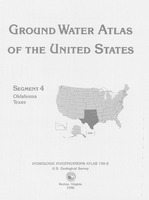Ground Water Atlas of the United States: Segment 4, Oklahoma, Texas
Links
- More information: USGS Index Page (html)
- Document: Report (60.52 MB pdf)
- Larger Work: This publication is Chapter E of Ground Water Atlas of the United States
- Download citation as: RIS | Dublin Core
Abstract
The two States, Oklahoma and Texas, that compose Segment 4 of this Atlas are located in the south-central part of the Nation. These States are drained by numerous rivers and streams, the largest being the Arkansas, the Canadian, the Red, the Sabine, the Trinity, the Brazos, the Colorado, and the Pecos Rivers and the Rio Grande. Many of these rivers and their tributaries supply large amounts of water for human use, mostly in the eastern parts of the two States. The large perennial streams in the east with their many associated impoundments coincide with areas that have dense populations. Large metropolitan areas such as Oklahoma City and Tulsa, Okla., and Dallas, Fort Worth, Houston, and Austin, Tex., are supplied largely or entirely by surface water. However, in 1985 more than 7.5 million people, or about 42 percent of the population of the two States, depended on ground water as a source of water supply. The metropolitan areas of San Antonio and El Paso, Tex., and numerous smaller communities depend largely or entirely on ground water for their source of supply. The ground water is contained in aquifers that consist of unconsolidated deposits and consolidated sedimentary rocks. This chapter describes the geology and hydrology of each of the principal aquifers throughout the two-State area.
Precipitation is the source of all the water in Oklahoma and Texas. Average annual precipitation ranges from about 8 inches per year in southwestern Texas to about 56 inches per year in southeastern Texas (fig. 1). In general, precipitation increases rather uniformly from west to east in the two States.
Much of the precipitation either flows directly into rivers and streams as overland runoff or indirectly as base flow that discharges from aquifers where the water has been stored for some time. Accordingly, the areal distribution of average annual runoff from 1951 to 1980 (fig. 2) reflects that of average annual precipitation. Average annual runoff in the two-State area ranges from about 0.2 inch in the western part of the Oklahoma panhandle and parts of west Texas to about 20 inches in southeastern Oklahoma.
Comparison of the precipitation and runoff maps shows that runoff is greater where precipitation is greater. However, precipitation is greater than runoff everywhere in the two-State area. Much of the precipitation that falls on the area is returned to the atmosphere by evapotranspiration, which is the combination of evaporation from surface-water bodies, such as lakes and marshes, and transpiration from plants. Part of the precipitation percolates downward through the soil and permeable rocks and is available for aquifer recharge throughout the area.
Oklahoma and Texas lie within six major physiographic provinces which are differentiated on the basis of differences in landforms and geology (fig. 3). The physiographic features vary greatly and range from the low, flat Coastal Plain Province through the high, gently rolling High Plains Province to mountain ranges in the Ouachita and the Basin and Range Provinces.
Study Area
| Publication type | Report |
|---|---|
| Publication Subtype | USGS Numbered Series |
| Title | Ground Water Atlas of the United States: Segment 4, Oklahoma, Texas |
| Series title | Hydrologic Atlas |
| Series number | 730 |
| Chapter | E |
| ISBN | 0607855428 |
| DOI | 10.3133/ha730E |
| Year Published | 1996 |
| Language | English |
| Publisher | U.S. Geological Survey |
| Contributing office(s) | Texas Water Science Center, U.S. Geological Survey |
| Description | 30 p. |
| Larger Work Title | Ground Water Atlas of the United States |
| First page | E1 |
| Last page | E30 |
| Country | United States |
| State | Oklahoma, Texas |


